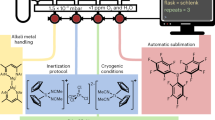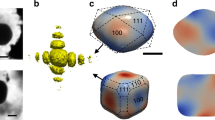Abstract
All real processes, be they chemical, mechanical or electrical, are thermodynamically irreversible and therefore suffer from thermodynamic losses. Here, we report the design and operation of a chemical reactor capable of approaching thermodynamically reversible operation. The reactor was employed for hydrogen production via the water–gas shift reaction, an important route to ‘green’ hydrogen. The reactor avoids mixing reactant gases by transferring oxygen from the (oxidizing) water stream to the (reducing) carbon monoxide stream via a solid-state oxygen reservoir consisting of a perovskite phase (La0.6Sr0.4FeO3-δ). This reservoir is able to remain close to equilibrium with the reacting gas streams because of its variable degree of non-stoichiometry and thus develops a ‘chemical memory’ that we employ to approach reversibility. We demonstrate this memory using operando, spatially resolved, real-time, high-resolution X-ray powder diffraction on a working reactor. The design leads to a reactor unconstrained by overall chemical equilibrium limitations, which can produce essentially pure hydrogen and carbon dioxide as separate product streams.
This is a preview of subscription content, access via your institution
Access options
Access Nature and 54 other Nature Portfolio journals
Get Nature+, our best-value online-access subscription
$29.99 / 30 days
cancel any time
Subscribe to this journal
Receive 12 print issues and online access
$259.00 per year
only $21.58 per issue
Buy this article
- Purchase on Springer Link
- Instant access to full article PDF
Prices may be subject to local taxes which are calculated during checkout



Similar content being viewed by others
Data availability
Data supporting this publication are openly available under an ‘Open Data Commons Open Database License’. The data, with additional metadata, are available at https://doi.org/10.17634/080913-1.
References
Dincer, I. & Cengel, Y. A. Energy, entropy and exergy concepts and their roles in thermal engineering. Entropy 3, 116–149 (2001).
Dunbar, W. R. & Lior, N. Sources of combustion irreversibility. Combust. Sci. Technol. 103, 41–61 (1994).
Dudukovic, M. P. Frontiers in reaction engineering. Science 325, 698–701 (2009).
Thursfield, A., Murugan, A., Franca, R. & Metcalfe, I. S. Chemical looping and oxygen permeable ceramic membranes for hydrogen production—a review. Energy Environ. Sci. 5, 7421–7459 (2012).
Adanez, J., Abad, A., Garcia-Labiano, F., Gayan, P. & de Diego, L. F. Progress in chemical-looping combustion and reforming technologies. Prog. Energy Combust. Sci. 38, 215–282 (2012).
Fan, L. S. in Chemical Looping Systems for Fossil Energy Conversions 241–249 (Wiley-AIChE, 2010).
Lyngfelt, A., Leckner, B. & Mattisson, T. A fluidised-bed combustion process with inherent CO2 separation; application of chemical-looping combustion. Chem. Eng. Sci. 56, 3101–3113 (2001).
Richter, H. J. & Knoche, K. F. Reversibility of combustion processes. ACS Symp. Ser. 235, 71–85 (1983).
Anhedena, M. & Svedberga, G. Exergy analysis of chemical-looping combustion systems. Energy Convers. Manag. 39, 1967–1980 (1998).
US Department of Energy Hydrogen and Fuel Cell Technical Advisory Committee Report of the Hydrogen Production Expert Panel (US Department of Energy, 2013); www.hydrogen.energy.gov/pdfs/hpep_report_2013.pdf
Lu, G. Q. et al. Inorganic membranes for hydrogen production and purification: a critical review and perspective. J. Colloid Interface Sci. 314, 589–603 (2007).
Giessler, S., Jordan, L., da Costa, J. C. D. & Lu, G. Q. Performance of hydrophobic and hydrophilic silica membrane reactors for the water gas shift reaction. Sep. Purif. Technol. 32, 255–264 (2003).
Basile, A., Criscuoli, A., Santella, F. & Drioli, E. Membrane reactor for water gas shift reaction. Gas Sep. Purif. 10, 243–254 (1996).
Noor, T., Gil, M. V. & Chen, D. Production of fuel-cell grade hydrogen by sorption enhanced water gas shift reaction using Pd/Ni-Co catalysts. Appl. Catal. B 150, 585–595 (2014).
Jang, H. M., Kang, W. R. & Lee, K. B. Sorption-enhanced water gas shift reaction using multi-section column for high-purity hydrogen production. Int. J. Hydrogen Energy 38, 6065–6071 (2013).
Jang, H. M., Lee, K. B., Caram, H. S. & Sircar, S. High-purity hydrogen production through sorption enhanced water gas shift reaction using K2CO3-promoted hydrotalcite. Chem. Eng. Sci. 73, 431–438 (2012).
Harrison, D. P. Sorption-enhanced hydrogen production: a review. Ind. Eng. Chem. Res. 47, 6486–6501 (2008).
Ortiz, A. L. & Harrison, D. P. Hydrogen production using sorption-enhanced reaction. Ind. Eng. Chem. Res. 40, 5102–5109 (2001).
Balasubramanian, B., Ortiz, A. L., Kaytakoglu, S. & Harrison, D. P. Hydrogen from methane in a single-step process. Chem. Eng. Sci. 54, 3543–3552 (1999).
Kathe, M. V., Empfield, A., Na, J., Blair, E. & Fan, L.-S. Hydrogen production from natural gas using an iron-based chemical looping technology: thermodynamic simulations and process system analysis. Appl. Energy 165, 183–201 (2016).
Mizusaki, J., Yoshihiro, M., Yamauchi, S. & Fueki, K. Nonstoichiometry and defect structure of the perovskite-type oxides La1-xSrxFeO3-δ. J. Solid State Chem. 58, 257–266 (1985).
Sogaard, M., Hendriksen, P. V. & Mogensen, M. Oxygen nonstoichiometry and transport properties of strontium substituted lanthanum ferrite. J. Solid State Chem. 180, 1489–1503 (2007).
Rydén, M. et al. Novel oxygen-carrier materials for chemical-looping combustion and chemical-looping reforming; LaxSr1-xFeyCo1-yO3-δ perovskites and mixed-metal oxides of NiO, Fe2O3 and Mn3O4. Int. J. Hydrog. Energy 2, 21–36 (2008).
Murugan, A., Thursfield, A. & Metcalfe, I. S. A chemical looping process for hydrogen production using iron-containing perovskites. Energy Environ. Sci. 4, 4639–4649 (2011).
Hodeau, J.-L. et al. Nine-crystal multi-analyser stage for high resolution powder diffraction between 6 and 40 keV. Proc. SPIE 3348, 353–361 (1998).
Acknowledgements
C.R.T. and C.d.L. thank EPSRC for funding via a doctoral training award. The research leading to these results has received funding from the European Research Council under the European Union’s Seventh Framework Programme (FP/2007-2013)/ERC grant agreement no. 320725 and from the EPSRC via grants EP/G012865/1, EP/J016454/1, EP/K029649/1, EP/P007767/1 and EP/P024807/1. The authors thank A. Fitch, C. Giacobbe, M. Coduri and O. Grimaldi at ESRF for help with XRD and T. Ingham, IGI Systems, for constructing the custom flow system and furnace. The authors also thank A. Coelho for developments in Topas to enable analysis of the multiple X-ray data sets produced, and B. Ladewig for help in producing the video.
Author information
Authors and Affiliations
Contributions
I.S.M. conceived the overall idea, secured funding and managed the work. I.S.M. and J.S.O.E. wrote the main text. I.S.M., B.R., W.H., C.d.L. and J.S.O.E. were responsible for the data analysis, modelling and interpretation. B.R., C.De., C.d.L., C.Du., F.R.G.-G., C.-M.M., E.I.P. and C.R.T. performed the experiments.
Corresponding author
Ethics declarations
Competing interests
The authors declare no competing interests.
Additional information
Publisher’s note: Springer Nature remains neutral with regard to jurisdictional claims in published maps and institutional affiliations.
Supplementary information
Supplementary information
Supplementary Methods, Supplementary Analysis, Supplementary Results, Supplementary Modelling, Supplementary Figs. 1–10, Supplementary Tables 1–6
Supplementary Video 1
A video that shows the principle of operation of the chemical memory reactor
Rights and permissions
About this article
Cite this article
Metcalfe, I.S., Ray, B., Dejoie, C. et al. Overcoming chemical equilibrium limitations using a thermodynamically reversible chemical reactor. Nat. Chem. 11, 638–643 (2019). https://doi.org/10.1038/s41557-019-0273-2
Received:
Accepted:
Published:
Issue Date:
DOI: https://doi.org/10.1038/s41557-019-0273-2
This article is cited by
-
Equilibrium shift, poisoning prevention, and selectivity enhancement in catalysis via dehydration of polymeric membranes
Nature Communications (2023)
-
A Discrete Second Order Sliding Mode Multiobserver Based on Multimodel Approach
Journal of Electrical Engineering & Technology (2023)
-
Chemical looping approaches to decarbonization via CO2 repurposing
Discover Chemical Engineering (2023)
-
Selective catalytic oxidation of ammonia to nitric oxide via chemical looping
Nature Communications (2022)
-
Precursor engineering of hydrotalcite-derived redox sorbents for reversible and stable thermochemical oxygen storage
Nature Communications (2022)



